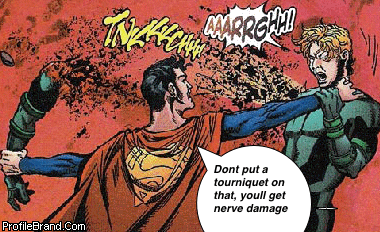I often use this space to give vent to annoyances that accumulate in my brain over a period of time because eventually the buildup reaches such a state that it interferes with my ability to write coherently on other topics. I fully intend to write about subject A, but three paragraphs in I’ve somehow morphed into a rant on annoyance B and it just goes downhill from there. Today is going to be one of those days. I need to rant a little bit about tourniquets.
Let’s start with some basic anatomy: The average human being has four limbs. Each of these four limbs is sustained by a network of arteries and veins which carry blood to the cells that make up the limb. The network of arteries and veins in the limb is hooked into a larger circulatory system by a major blood vessel. Each arm has a brachial artery, and each leg has a femoral artery. These arteries are fairly large and because they supply the blood that feeds an entire limb they contain a lot of blood under considerable pressure. If one of these arteries is severed, massive blood loss will result. Loss of more than 15% of total blood volume will severely impair your ability to function. (Loss of consciousness may result) Losing more than 30% of your total blood volume is most likely to prove fatal. With a major arterial bleed it is possible to lose a fatal amount of blood volume in seconds. The human body fights the loss of blood through a clotting mechanism, but with a major arterial bleed the loss is too big and happening too fast for this clotting mechanism to do any good. To prevent loss of life the bleeding has to be stopped by some sort of emergency intervention.
Hence the invention of the tourniquet. The brachial and femoral arteries are nestled beneath layers of muscle tissue, fat tissue, and skin to protect them from damage. This arrangement also tends to make it difficult to get at them should some form of penetrating trauma sever one of the arteries. Where application of direct pressure might stop the bleeding if you cut your hand preparing dinner, the same may not be possible with a femoral or brachial artery that’s been torn open by a bullet. Getting a proper tourniquet upstream of the wound can stop or at least dramatically slow the loss of blood through the ruptured artery, buying the victim more time to receive life saving medical treatment.
Simple stuff, right? For many years first aid instruction has eschewed the use of tourniquets because of worries about the potential dangers of misapplying one. If properly used the tourniquet is essentially cutting off blood flow to a limb, which can indeed result in all sorts of nasty side effects…especially if it is left in place for an extended period of time. That’s why the American Red Cross, the largest provider of first aid training in the United States, says:
“Because of the potential for adverse effects, a tourniquet should be used only as a last resort in cases of delayed care or situations where response from emergency medical services (EMS) is delayed, when direct pressure does not stop the bleeding, or you are not able to apply direct pressure. ”
As a result of this sort of concern and the boilerplate warnings that Red Cross trained first aid teachers have been giving for years, when someone asks about getting a tourniquet to keep handy in case of emergency there’s no shortage of people coming out of the woodwork to warn about the dangers from misapplying a tourniquet. Gun Nuts isn’t a medical site and I’m not a doctor. I am, however, a dude with eyes and ears and I’ve noticed that there are a whole bunch of people alive and kicking today with no nerve damage or limb loss after having a tourniquet used on them. People who would have been dead if somebody had stood around waiting for EMS to show up before applying the damn tourniquet.
The thing about the nasty side effects I mentioned earlier is that it typically takes an extended period of time for them to manifest. If you leave a tourniquet in place for more than a couple of hours there can be significant complications that require sophisticated medical intervention to treat…but if you are in Albuquerque New Mexico dealing with a sheriff’s deputy bleeding badly from a gunshot wound sustained in the effort to try and stop an active shooter, worries about what might happen to her leg if the tourniquet is left on for 6 hours are irrelevant.
Let’s be absolutely clear on this: The point of a tourniquet is to stop or significantly slow a bleed in an extremity that will be fatal in a matter of seconds. We’re not talking about a scraped shin, here. We’re talking about some sort of penetrating trauma (or, as in the Boston marathon perhaps even traumatic amputation) that’s torn or severed major blood vessels that normally live fairly deep in the body. Good luck applying direct pressure to that. While I suppose it’s probable that somewhere there’s a person stupid enough to apply a tourniquet on an injury where only a couple of drops of blood are evident, I think it’s much more likely that there are a bunch of people who will hesitate to buy or use a tourniquet when it’s the proper tool for the job due to all the fear mongering…which can lead to an unnecessary loss of life.
Just as there are times where a firearm is the proper defensive tool to use and occasions when drawing said firearm and shooting another human being in the vital organs is the appropriate and necessary response to a situation, there are occasions where the tourniquet is the proper tool for the job and getting it cinched on a wounded person is the first thing you should do. There is a reason why every infantryman in the military has an individual first aid kit (IFAK) that includes a tourniquet. There is a reason why more and more fire departments, police departments, and other emergency services are purchasing tourniquets for their personnel.
The thinking that applying a tourniquet is something that you do under the rarest of circumstances is outdated. The medical community here in the states has been slow to integrate some of the learning from the emergency response lessons learned in Iraq and Afghanistan into their thinking, but after events like Albuquerque and the Boston Marathon bombing it’s becoming pretty clear that the tourniquet saves lives and should be a part of any medical response kit.
Don’t be dissuaded from buying a tourniquet by well meaning people repeating outdated first aid mantras about them. By all means, buy one or a kit that comes with one. The SOF-T from Tactical Medical Solutions is widely regarded as the best on the market if you’re wondering which one you should get. Then follow that up with a decent medical response training course that will teach you how and when to use the tourniquet as a life saving tool.
Tourniquets are a good thing. As a side effect of war we have extremely effective, simple to use options on the market like the SOF-T. There are quality courses teaching the proper use of these items from Dark Angel Medical, Active Response, and other quality outfits popping up all over the country. Take advantage of it, folks. Contrary to what some politicians might wish you to believe, the world is not becoming a calmer, more placid place anytime soon.

Is it still cool to buy and wear the pants/shirt combo with built in tourniquets for each limb?
EMS systems are changing. In my state (Massachusetts) the old EMS treatment protocol for extremity hemorrhage was direct pressure -> limb elevation -> pressure point -> tourniquet. The new protocol is direct pressure -> tourniquet.
In fact, the July issue of GunUp The Magazine should have a review of just such a course.
as a former ER nurse i could not agree with this more.
I think I know where your frustration started. I blame Rusted. I bought a tourniquet a while ago, and need to add more to my medical stash.
While less harmful to underlying tissues, tourniquets are regularly used in limb surgeries. Of course they must be relieved at intervals to avoid untoward effects but they are a reminder that tourniquets are not the evil some make them out to be. Saving a life is a far greater priority than being concerned about avoiding any chance of the loss of limb that could have possibly been saved with expedient care. I’ve never seen a patient who lost one limb and did not return to a functional level far better than that of the grave.
You’ve got this one backwards. “Then follow that up with a decent medical response training course that will teach you how and when to use the tourniquet as a life saving tool.”
Get the training FIRST. It doesn’t matter if it’s a tourniquet or any other piece of gear – if you are carrying it around and you don’t know how to use it, it’s a liability rather than an asset…..
Wait, has somebody removed the radial and ulnar arteries from the arm?
Direct pressure is preferred. If the bleeding persists while applying dirfect pressure, then tourniquets may be appropriate. If you have blood spurting and you can’t plug the dike, use the tourniquet while someone calls 911.
I have been able to control arterial bleeding from distal limbs with direct pressure on an artery proximal to the wound – it’s worth a try but be prepared to step up to a tourniquet.
Just go straight to a tourniquet, this has been proven from the last decade of combat experience. Why waste blood trying something that might not work. 18delta, pig labs, any trauma training says this.